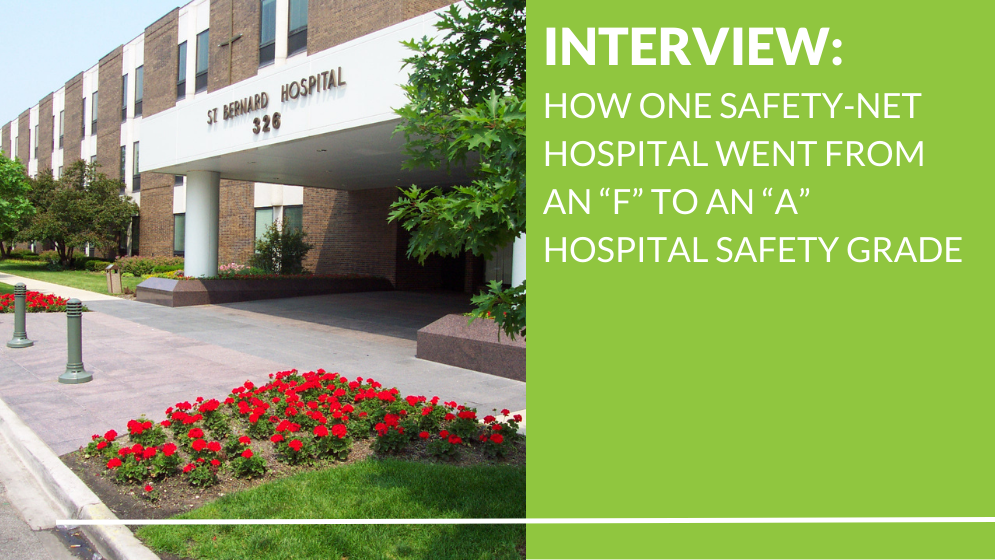
Leapfrog CEO Leah Binder interviews leaders from St. Bernard Hospital in Chicago
Leapfrog awards Hospital Safety Grades to nearly 3,000 general acute-care hospitals across the nation twice annually. Using a tested methodology under the guidance of a world class expert panel, Leapfrog calculates a single letter grade on how each hospital compares in keeping patients safe from preventable harm and medical errors.
In spring 2021, St. Bernard Hospital, a safety-net hospital on the South Side of Chicago, earned an “F” on The Leapfrog Group Hospital Safety Grade. Though this was distressing, CEO Chuck Holland led the hospital forward and ultimately inspired the community as well as national leaders with his determined journey to improve. That work saved lives. In the spring 2023 round of Hospital Safety Grades, St. Bernard earned its first “A” Hospital Safety Grade, and in fall 2023, the hospital once again earned an “A.”
Mr. Holland was also honored at the 2023 Leapfrog Annual Meeting with the Steven Schroeder Award for Outstanding Healthcare CEO, which is jointly presented by The Leapfrog Group and Costs of Care, for his efforts in patient safety and health care affordability. St. Bernard has also received extensive media coverage for their outstanding accomplishments.
In this interview, Leapfrog President and CEO Leah Binder discusses St. Bernard’s progress with CEO Chuck Holland and Chief Quality and Patient Safety Officer Michael Richardson.

Leah Binder: I am delighted to be joined today by two people who are from a hospital that has truly inspired all of us at Leapfrog. Our board, our community, and our leaders throughout the country have been truly impressed by the accomplishments of this wonderful hospital. I'm not going to tell their remarkable story, I’ll let them do that. I'm joined by CEO of St. Bernard Hospital in Chicago Chuck Holland and Chief Quality and Patient Safety Officer Michael Richardson. Welcome to you both and thank you again not only for joining me today but also for your inspirational achievement for your community. Let's start with a question for Chuck, St. Bernard’s CEO. First, why don't you tell us something about St. Bernard Hospital and a challenge that you faced?
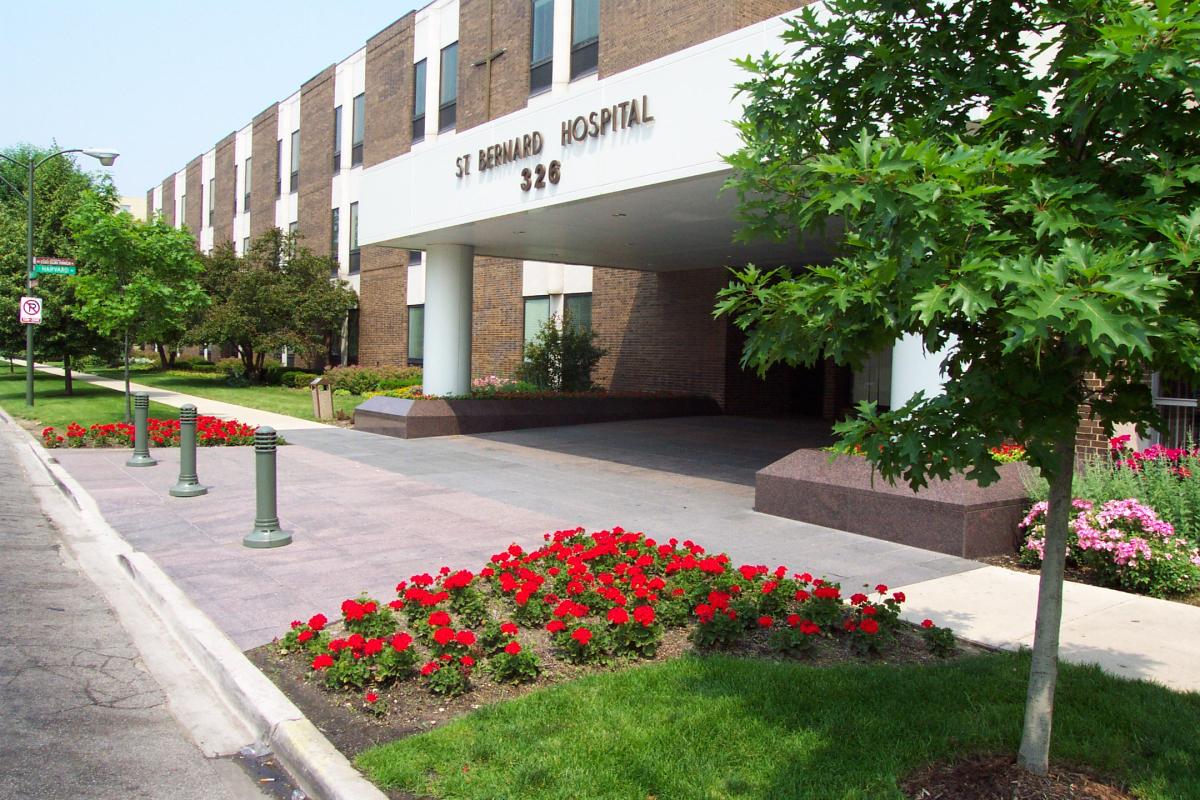 Chuck Holland: Thank you, Leah. I appreciate this opportunity to be here to talk about St. Bernard Hospital and the accomplishments we've made in patient safety. St. Bernard is an independent Catholic community hospital located on the South Side of Chicago. We're a safety-net hospital, which means greater than 50% of our patients have Medicaid as their source of payment for hospital services. We are very constrained financially because Medicaid doesn't cover the cost of care for our hospital. We rely on managing our expenses very well and supporting the healthcare resources we provide to the community.
Chuck Holland: Thank you, Leah. I appreciate this opportunity to be here to talk about St. Bernard Hospital and the accomplishments we've made in patient safety. St. Bernard is an independent Catholic community hospital located on the South Side of Chicago. We're a safety-net hospital, which means greater than 50% of our patients have Medicaid as their source of payment for hospital services. We are very constrained financially because Medicaid doesn't cover the cost of care for our hospital. We rely on managing our expenses very well and supporting the healthcare resources we provide to the community.
As I mentioned, we’re an independent community hospital; we don't belong to any other system. We pull together as a team to address the issues of health care for the community and the issues of patient safety that we're going to talk about today. The hospital is also the largest employer in the community, so we're a huge economic engine as well. In the 120 years that St. Bernard Hospital has been in the community, we have lived up to our mission to welcome all patients with high-quality care and address the community’s health care needs as comprehensively as we can.
Leah Binder: Two years ago, Leapfrog gave you some bad news. Fast forward two years, and you gave us some good news. Want to tell us what that is?
Chuck Holland: Well, when we first learned about the grade that we received in The Leapfrog Group ratings on patient safety—and that was two and a half years ago—I was taken aback. My team and I thought we were all doing what we needed to do to address patient safety. The first thing I asked my team when we learned about “F” grade was who is in charge of patient safety, and whose efforts are focused on keeping people safe in the hospital. I didn't get a good answer, and that surprised me.
As it turned out, there was no one person who was totally focused on patient safety and leading our efforts in improving patient safety. That was a huge concern of mine. Don't get me wrong: I thought we were doing things to address patient safety in the hospital. But it wasn't comprehensive, and it wasn't coordinated. The first thing we decided was that we needed a senior team leader who was totally focused on patient safety and whose job it was to address patient safety in a comprehensive way, advocate for patient safety, and advance all programs related to patient safety in the hospital.
I was very fortunate to hire Michael Richardson as the chief quality and patient safety officer. His expertise and skill have been vital to this process. But we needed a roadmap and to know what we had to do. What do we need to focus on? What's important to focus on? What steps do we need to take initially to begin to improve patient safety in the short term and in the long term?
That's where The Leapfrog Group Hospital Survey provided the instrument for us to create that roadmap and assess where we were at. In turn, it provided directions for where we needed to go as well as measures for what we are accomplishing and tasks for what we still needed to accomplish.
Leah Binder: Michael, what did you do first?
Michael Richardson: That was a journey. When I first got here, somebody literally walked into my office and said, “Hey, I think this is yours” and handed me a binder. I said, “What is this?” It was the Leapfrog Hospital Survey. It was breaking things down to questions such as what the state of the nation was at St. Bernard. What was going on? What were the kind of things that we needed to fix immediately? And what could we fix immediately?
We started on that journey, breaking down the Survey, and then started essentially having lots of conversations because I think everything starts with that. I asked, “What are the barriers? What are the challenges that we have? Obviously, a big concern for us at the time was medication safety. Looking at the Leapfrog Hospital Survey and looking at the data, we realized we definitely weren't where we needed to be. We began to put things in place immediately to correct that.
As you know, thousands of patients die every year because of medication errors, so we fixed that first. I'm happy to say that, for the last year and a half, we've been well above the 95% requirement for safe medication administration. That was one of the first things we tackled, and it went on from there. We asked more questions: How can we fix computer physician order entry? How do we fix our hand hygiene? We've put a lot of things into place, and it's an ongoing process. To Chuck's point, using the Leapfrog Hospital Survey as a roadmap has definitely helped us to stay on that path.
When we participated in the Leapfrog Hospital Survey, it opened up a whole new avenue for us of things we needed to focus on and ways in which we could improve safety—where we needed to start and where we needed to get to.
— Chuck Holland
Leah Binder: Hand hygiene was one area you put a great deal of emphasis on. Why?
Michael Richardson: You know, secret shoppers work, but it's very time-consuming. It's labor intensive. You have to gather all that data and pull it together. I talked to the board and Mr. Holland and our infection preventionist. We looked at the three different companies that offer electronic hand hygiene monitoring and chose the BioVigil system because that met our needs. It allowed that accountability down to the individual so we can address the issues or behavioral issues with the individual and share that information back to them.
We’re happy with the BioVigil system. In just over a year and a half, I think we're already into nearly 1.5 million captured episodes of hand hygiene. We have a compliance rate, which is creeping up to where we're at 90% to 93%. I think that's a great achievement.
Leah Binder: Before a lot of hospitals get an electronic monitoring system, they think they have high rates of compliance. When they do electronic monitoring, they find out it's not as high as they thought.
Michael Richardson: We thought we were doing a good job. But when it comes to consistency, you realize that by having this stronger data, you can actually change the course. It gives you something to look back on.
Leah Binder: Nursing is usually the largest group within the hospital workforce, and they are critical to patient care and certainly protect patient safety. Tell me about how you engage nurses and used their leadership in the change that you made. You had to have worked with some extraordinary nurses.
Michael Richardson: You're absolutely right. Nurses play a crucial role when it comes to patient safety. It was important to make sure that we had systems in place that allowed the nurses to stop potential errors getting through to the patient. Engaging nurses in the culture of safety starts with onboarding. When they first come to the hospital, they have a one-hour session with me on patient safety where I talk about what causes errors rather than just talking about quality measures and The Joint Commission. We talk about what causes patient errors. It's a very engaging session.
It's brutal in that the first question I ask is how many people die every year in the United States because of medical errors. You and I know that the number is in the hundreds of thousands. That makes them a little bit somber, but then we start to engage them. Why is that question important? Why is that number important? Maintaining that strong nursing safety culture is driven from the top. It must come from senior leadership, all the way from CEO and the CNO.
Nurse managers all play an important role when it comes to patient safety. Driving that message from the top down is done through leadership rounds, and we have structured leadership rounding, but we also have in-the-moment leadership. For rounding, Mr. Holland and I will walk around each department—not just nursing, but to all the departments—and ask them questions about patient safety. It's important to make sure that we close the loop when we asked nurses to put in event reports, and it's important that we give them that feedback. We appreciate them getting the event logged in a non-fearful way. We're not chasing them; we're chasing the system errors. We're trying to drive that message.
And we also introduced a just culture model to all our managers and leaders. It’s a shared responsibility between leadership to make sure that employees work safely to prevent errors. Also, the employees have a responsibility to make those quality choices when they're making decisions about providing patient care. I think all that helps when we're talking about how to engage nurses and employees. Recognition is important. We want to recognize those employees for the good work that they do. We recently recognized 20 individuals, and that sends a message across the organization that we do see them. Leadership does care about patient safety, and we want to support their efforts.
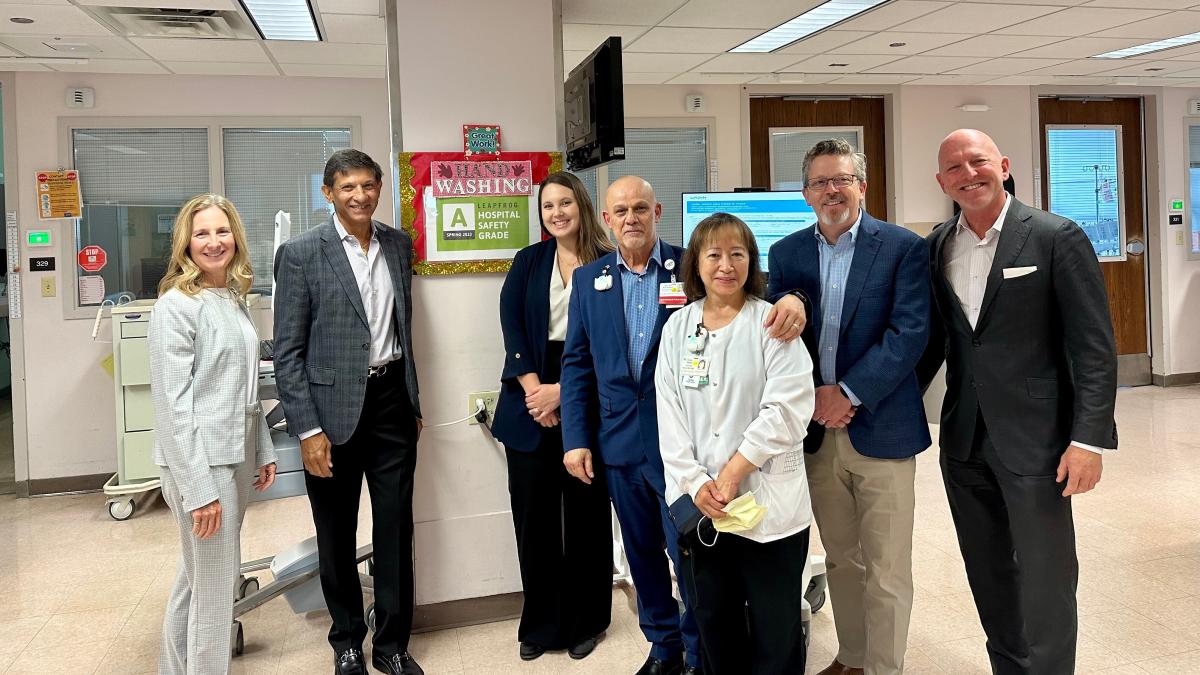
2023 Bruce Bradley Fellows Janet McNichol, Suresh Mukherji, Kayley Delashmit, and Gary Howell; Regional Leader Mark Pfleger; and Chief Quality and Patient Safety Officer Michael Richardson Michael Richardson and ICU Director Emma Reyes.
Leah Binder: I am a big believer that part of the reason we have so much burnout nationally, among nurses and physicians, is that many of them feel that the purpose of their life work isn’t recognized, or it's not consistent with the values of the organization they work for. That's where your work to show that leadership is going to stand forward on behalf of patient safety sends the right message. That has got to have a big impact on everyone who works there. I salute that.
Chuck Holland: I just want to mention, too, that when you're talking about recognizing folks, we started changing the language that we use in the hospital when talking about patient safety. I started talking about patient safety in a way that I hadn't before. It does help shift the perception and emphasize that we're changing culture here to prioritize safety. It's a whole-house effort, with all staff involved. As Michael said, it starts from the top down. I recognized how I needed to change the way I talk about patient safety and the way I include everyone in that effort. I think that's made the difference.
People begin to identify patient safety as an effort that's not just over here in a box somewhere; it’s a comprehensive responsibility for the entire team.
— Chuck Holland
Leah Binder: Can you give me an example, Chuck, of how you changed the way you talk about patient safety?
Chuck Holland: In management meetings, I used examples of how safe practices also impact quality of care and patient perception. Talking about patient safety in our rounding, you get feedback from employees. They think, “Oh, yeah, something occurred the other day or a practice that we have here may impact the way we address patient safety.” It helps tease out more responses from folks than I had realized before. People begin to identify patient safety as an effort that's not just over here in a box somewhere; it’s a comprehensive responsibility for the entire team.
Leah Binder: A lot of the change that you're talking about happened during the pandemic, so I presume that St. Bernard hospital had some major challenges then. Yet, when we look at your data, you showed a significant decrease in your health care–associated infection rates, which is pretty much the opposite of where the rest of the country went. Most hospitals nationally saw a significant increase in health care–associated infections during the pandemic. How did you accomplish that?
Michael Richardson: Because I joined St. Bernard halfway through the pandemic, I was impressed at what they'd done. I asked a lot of questions. How did you manage this, considering the patient population that surrounds St. Bernard was more vulnerable than the general population? But they put things into place. They got capital investment to convert all the ED and ICU units and OR rooms into negative pressure rooms, as well as some of the additional rooms on the med-surg floor.
We were also fortunate to have a very strong infection preventionist leader who was able to guide the whole team through all the regulatory changes, which sometimes felt like it was on a daily basis. She was able to corral all that information together and share it. When it came to PPE, I've worked in organizations that were struggling, literally recycling N-95 masks and making their own PPE. St. Bernard seemed to have a good stockpile and never had an issue with PPE. That sends a positive message to the employees as well, who obviously had their own concerns about this pandemic.
But like every organization, it wasn't perfect. St. Bernard had to adapt on the fly to make changes and just try to stay ahead of it. I think that they've fared very well because of that.
Culture is one of those things that takes time. Cultural change is a journey, and we're still on that journey.
— Michael Richardson
Leah Binder: Well, I think your culture clearly had to have shifted in order for you to have accomplished that much and defied all the odds. Tell me about how your culture changed.
Michael Richardson: Culture is one of those things that takes time. Cultural change is a journey, and we're still on that journey. To Chuck's point earlier, St. Bernard had a safety program, but it just wasn't all put together. Infection prevention was working, nursing was working, but how were they trying to come together? There was some separation between the departments.
Then in 2021, we did our culture of safety survey. I wasn't here yet but had arrived just after. It was a little bit dire, to be honest. We had a very meager 60% participation rate. That doesn't give you a true picture of what was going on with the culture. In 2023, we decided we needed to invest in trying to get that participation rate up. We set a goal, which I knew at the time was probably high, but we said we were going to aim for 80% participation. I’m happy to have to report we've surpassed that—we went all the way up to about 88% participation rate. That gives us a true picture of what the employees feel about the culture of safety.
Then if you add that to achieving some changes from the “F” grade—we went to a “C” grade, to a “B” grade—I think the employees could feel that there was a change in culture. Then of course, reaching the “A” grade boosted morale and engagement. We now have things that we know we need to fix because of the Leapfrog Hospital Survey, but at least we had something tangible that we could work on.
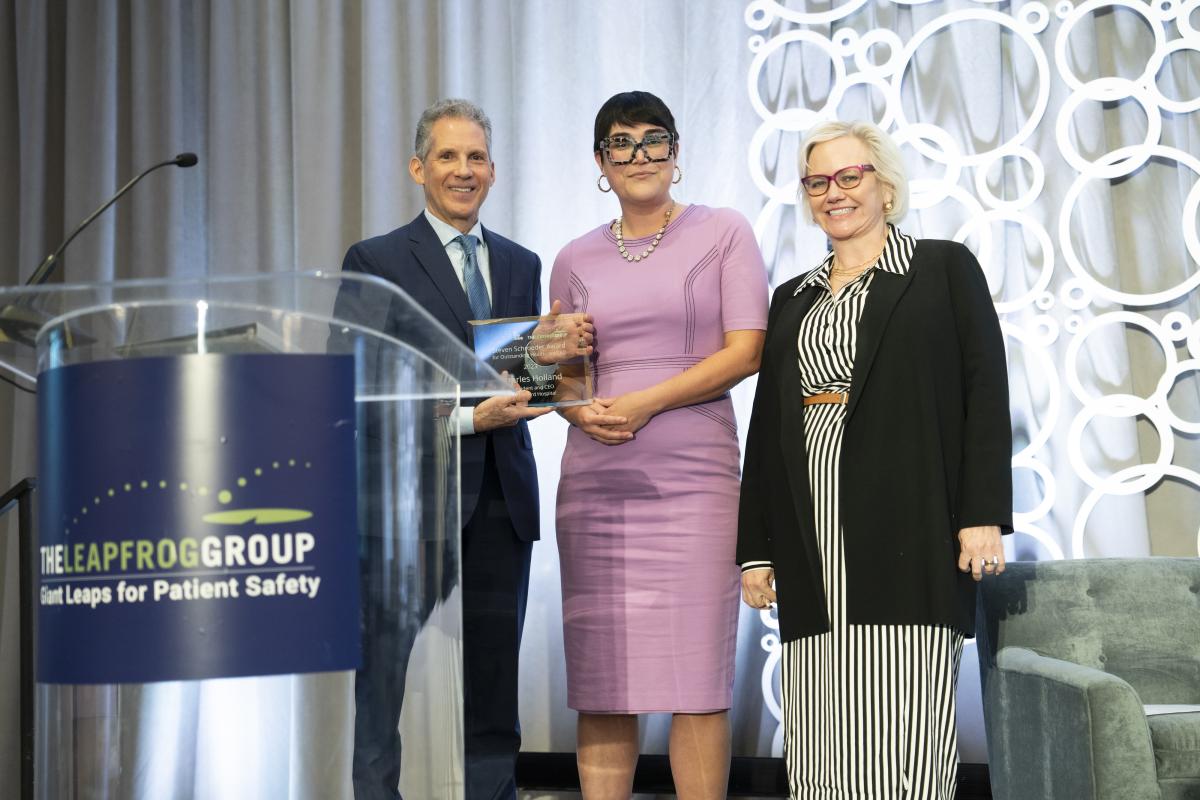
St. Bernard Hospital CEO Charles Holland with Costs of Care Director Fumiko Chino and Leapfrog Group President and CEO Leah Binder
Leah Binder: Well, it's certainly good for us to hear. We know that working toward transparency, setting goals, and measuring your progress can have impact in and of itself—even though it can be difficult. Sowe appreciate that you were able to use the Leapfrog Hospital Survey so constructively. Let me ask a question for Chuck: How have you seen your community react to your work in patient safety?
Chuck Holland: I've seen it all very positively. There's just a greater energy about our achievements, number one, and greater energy around maintaining that.
I'll share one example with you about how the community was impacted. St. Bernard Hospital participates in what's called the Healthcare Transformation Collaborative. It involves 13 hospitals and federally qualified health centers on the South Side of Chicago all working together to address care coordination, access to care, and provider recruitment issues. We can look at the South Side and at our efforts as like a quasi-health system trying to work together to coordinate care for patients in the most effective way possible. These are organizations that the hospital's been familiar with for many years. We've sometimes had competitive relationships with those other hospitals, but also good working collaborative relationships with them.
Each organization has a board member, and at last week's board meeting, I was very surprised when one of the board members wanted to take what she called the “mission moment” to recognize St. Bernard’s efforts in improving patient safety and how important she felt that was for all of the institutions that were gathered together. She told several stories about her experiences, personally, and the experiences she heard from her patients about how things had changed at St. Bernard. There is a greater emphasis on quality and safety, and she could feel it. She was very happy about that and was congratulating the hospital in front of all of the other institutions there. That was a great moment for me that showed our efforts had gotten out to the community and also to the other institutions that provide care for the community.
Michael Richardson: We recognize that not only is the culture around safety a journey, but also the culture around patient experience is a journey. We've just hired a director of patient experience and employee engagement to have the same focus on experience that we did on patient safety because there's a direct correlation between the two. We also just got a generous donation from Surfacide, who donated the Helios system, and we want to use that technology and translate that into patient experience so the patients and their families can see that even small community hospitals like St. Bernard can have the same technology as the larger tertiary hospitals that surround us. We want to send the message that St. Bernard is a safe hospital. It's great for employers and the community, too.
I would let my colleagues know that improving patient safety does take an upfront investment, and I think that's an investment also in the way we talk about patient safety … if we're serious about patient safety and health equity, we have to walk the talk.
— Chuck Holland
Leah Binder: Chuck, you just told a great story about collaborating with your colleagues and getting recognized by them. What advice do you offer colleagues in light of what you’ve learned?
Chuck Holland: Leah, I think that I would let my colleagues know that improving patient safety does take an upfront investment, and I think that's an investment also in the way we talk about patient safety. It's a human investment, if you will, and it's also a monetary investment. But I think if we're serious about patient safety and health equity, we have to walk the talk. In our case, that investment was first and foremost in the expertise that Michael Richardson brings to the table, and then in technology.
It was a concerted effort to say we needed to invest in this; we need to spend dollars to improve patient safety, especially for safety-net hospitals like St. Bernard. Investing in patient safety also creates other opportunities. That's what I'd let my colleagues know: It's not just that you're going to have to spend money to address patient safety and get a better grade, but it also creates other opportunities for you. We're a perfect example of that. It shows the community, it shows the staff—many who are from the community itself—that we're serious about patient safety, and quality outcomes are better in the hospital.
We're proving this by actions, not just by our words. St. Bernard Hospital, truly cares about your well-being. It shows to the board, to our payors, and to the state of Illinois in particular that we can provide high-quality care when an investment is made. When you invest resources in a focused way to improve patient safety, it creates other opportunities.
We're thinking and hoping that we have evidence of a good return on our investment. I'd say to my other colleagues that this is the case: We’ve improved both staff morale and patient outcomes. Now I hope that also begins to translate down to increased reimbursement and financial support from payors like our Medicaid payors and our managed care payors who see that an investment in patient safety results in better outcomes for the patients who are seen and given health care at our hospital.
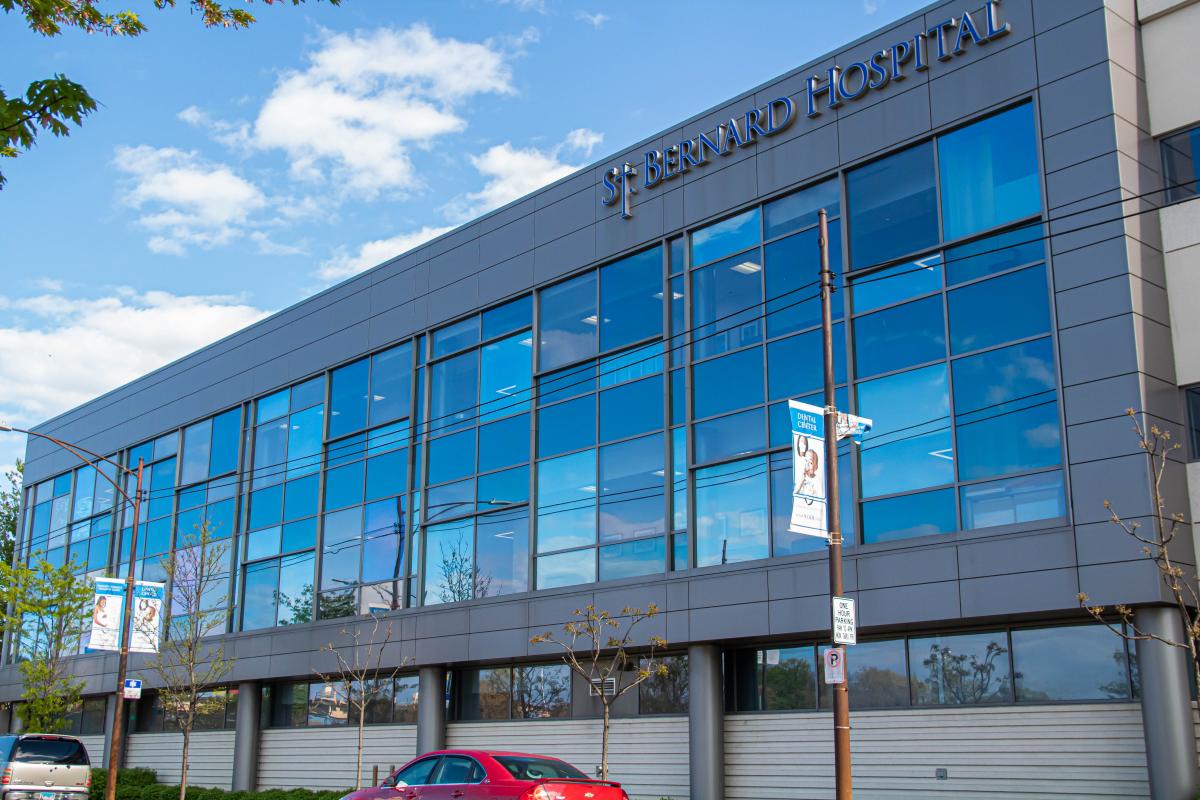
Leah Binder: I think greater patient safety is what happens when you put patients first. In fact, the only way to achieve safety is putting patients first, period. Anything else you'd like other hospitals to know about your experience?
Michael Richardson: My advice would be don't shy away from the Leapfrog Hospital Survey. If you participate and you're struggling, or you've not participated, then I encourage you to do so. Transparency in health care is important, and that's what we're trying to do here. We're trying to look at where we are and stay on that journey, regardless of the fact that we can't predict what's coming in the future, but we will definitely stay on that safety journey.
Chuck Holland: As I mentioned, we thought we were doing everything we needed to do to address safety, and we had not participated in the Leapfrog Hospital Survey. When we participated in the Survey, it opened up a whole new avenue for us of things we needed to focus on and ways in which we could improve safety—where we needed to start and where we needed to get to. I would say don't be afraid, participate in the Survey because it's a helpful tool. I’ll admit I had my concerns early on about the Survey itself as actually measuring what we were doing to address patient safety. Now I can see that it was beneficial to us in the long run. You have to make that commitment to advance patient safety because it is going to create other opportunities for you. As you said, Leah, it does put the patient first when you focus on patient safety as your issue.
Leah Binder: Well, first I want to thank you for giving all of us at Leapfrog this acknowledgment that what we're doing is making a difference. Mostly, thank you for what you've done to save lives of people in your community and to make such a difference in your hospital for all the people you serve. That's what it's all about us. You've inspired more than just us at Leapfrog; you’ve inspired the country and shown what can be done against all odds. Thank you for that example and for being with me today to tell your story.
